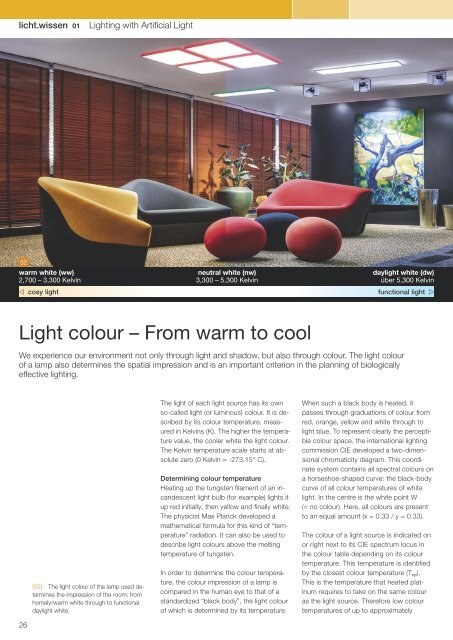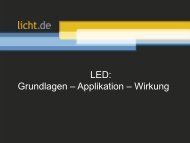licht.wissen No. 01 "Lighting with Artificial Light"
Booklet 1 is intended for all those who want to delve into the topic of light and lighting or wish to familiarize themselves with the basics of lighting technology. It also helps to make a decision in the field of lighting. Free Download at www.licht.de/en
Booklet 1 is intended for all those who want to delve into the topic of light and lighting or wish to familiarize themselves with the basics of lighting technology. It also helps to make a decision in the field of lighting. Free Download at www.licht.de/en
You also want an ePaper? Increase the reach of your titles
YUMPU automatically turns print PDFs into web optimized ePapers that Google loves.
<strong>licht</strong>.<strong>wissen</strong> <strong>01</strong><br />
<strong>Lighting</strong> <strong>with</strong> <strong>Artificial</strong> Light<br />
52<br />
warm white (ww) neutral white (nw) daylight white (dw)<br />
2,700 – 3,300 Kelvin 3,300 – 5,300 Kelvin über 5,300 Kelvin<br />
cosy light<br />
functional light <br />
Light colour – From warm to cool<br />
We experience our environment not only through light and shadow, but also through colour. The light colour<br />
of a lamp also determines the spatial impression and is an important criterion in the planning of biologically<br />
effective lighting.<br />
[52] The light colour of the lamp used determines<br />
the impression of the room: from<br />
homely/warm white through to functional<br />
daylight white.<br />
The light of each light source has its own<br />
so-called light (or luminous) colour. It is described<br />
by its colour temperature, measured<br />
in Kelvins (K). The higher the temperature<br />
value, the cooler white the light colour.<br />
The Kelvin temperature scale starts at absolute<br />
zero (0 Kelvin = -273.15° C).<br />
Determining colour temperature<br />
Heating up the tungsten filament of an incandescent<br />
light bulb (for example) lights it<br />
up red initially, then yellow and finally white.<br />
The physicist Max Planck developed a<br />
mathematical formula for this kind of “temperature”<br />
radiation. It can also be used to<br />
describe light colours above the melting<br />
temperature of tungsten.<br />
In order to determine the colour temperature,<br />
the colour impression of a lamp is<br />
compared in the human eye to that of a<br />
standardized “black body”, the light colour<br />
of which is determined by its temperature.<br />
When such a black body is heated, it<br />
passes through graduations of colour from<br />
red, orange, yellow and white through to<br />
light blue. To represent clearly the perceptible<br />
colour space, the international lighting<br />
commission CIE developed a two-dimensional<br />
chromaticity diagram. This coordinate<br />
system contains all spectral colours on<br />
a horseshoe-shaped curve: the black-body<br />
curve of all colour temperatures of white<br />
light. In the centre is the white point W<br />
(= no colour). Here, all colours are present<br />
to an equal amount (x = 0.33 / y = 0.33).<br />
The colour of a light source is indicated on<br />
or right next to its CIE spectrum locus in<br />
the colour table depending on its colour<br />
temperature. This temperature is identified<br />
by the closest colour temperature (T cp ).<br />
This is the temperature that heated platinum<br />
requires to take on the same colour<br />
as the light source. Therefore low colour<br />
temperatures of up to approximately<br />
26

















